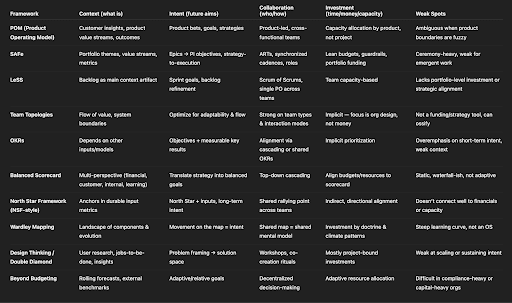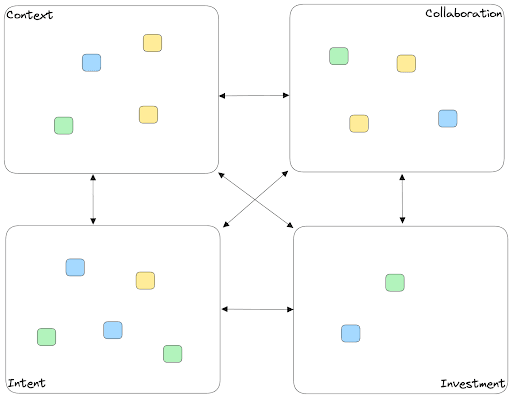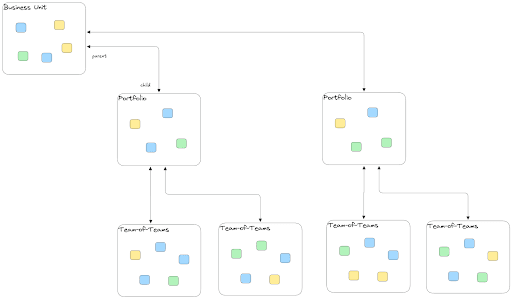DotPacks: A Smarter Starting Point for Adapting Dotwork
DotPacks: A Smarter Starting Point for Adapting Dotwork
Most tools in this space are rigid. They force teams into narrow ways of working, which often leads to a shadow operating system — a separate set of behaviors and rituals that don't quite fit the tool. Dotwork is different: it’s flexible and customizable by design. But that same flexibility can be overwhelming. Enter DotPacks.
DotPacks are curated starter configurations for Dotwork. Some translate known models or frameworks into a ready-to-use format. Others capture broader principles or practices from real organizations that teams might want to try. Dotpacks are built to “get you 80% of what you want/need in Dotwork”, and accelerate the changes to the remaining 20%.
They’re not just collections of templates. DotPacks are curated by our team and our partners, who draw from years of experience to help teams avoid common friction points — like how to name things or structure them. We also anticipate the rituals that go with each framework, designing supporting visualizations and interactions alongside the structure.
Ultimately, while every company’s operating system shares some common DNA, the interesting parts — the things that define a team’s way of working — often lie in the differences. DotPacks help teams focus on those meaningful variations without starting from scratch.
We’re also collaborating with advisors to build future DotPacks that embed their hard-won insights. Because at the end of the day, a tool alone won’t change how a company works. But it can support the people doing that hard work — and that’s what DotPacks are for.

Dotpacks help organizations quickly adopt, learn, and then adapt, by reducing the time needed to start experimenting with promising ideas, whether it’s from a well-known operating model, or a locally-sourced innovation. It’s built to help you explore any new idea, like some way of working that is not currently in place in that part of the organization.

Figure 1: Dotpacks provide an object model to instrument a known, defined operating system
Dotwork Dotpacks serve three main purposes:
- Accelerate the time-to-value when activating the Dotwork platform
- Reduce the learning curve for organizations exploring new operating system practices
- Encourage extensions and variations of practice, relative to the industry models
Each Dotpack provides a rich object model (i.e. ontology) derived from its source model. An instantiated Dotpack is designed to elicit meaningful content and connections across the four subgraphs that support decision making in a modern operating system:
- Context - model(s) of the environment that shape and define the mission
- Collaboration - the way teams are formed and rituals are defined
- Intent - choices of which changes to pursue, and what success looks like
- Investment - the fuel for the changes, allocated based on key trade-off decisions

Figure 2: Dotpack elements provide broad coverage across the four critical subgraphs
Dotpacks also provide support for modeling your unique organizational design. Organizational units (like business units, portfolios, departments, teams-of-teams, etc.) are modeled as Spaces in Dotwork. Each space has distinct lists of objects, and these boundaries help organizations define meaningful backlogs, measurements, and accountabilities, within the operating system.
Each Dotpack offers an example set of Spaces, as types, that guide the application of the Dotpack to your organization. These Space Types manage a subset of the objects in the object model. Together with the object model, the spaces bring the full operating system to life.

Figure 3: Dotpacks define Space Types to help map the org design to the operating system
While the Dotpack can be installed “in full”, as an off-the-shelf Dotwork configuration, it can also be pared back, to support initial pilots with more modest scope. Each Dotpack classifies the parts of its design from essential to supporting to extensions, to help leaders make tradeoff decisions while planning their organizational change journeys, or while sponsoring local experimentation.

Figure 4: Dotpack elements are classified to support incremental adoption and experimentation
Dotwork will be releasing new Dotpacks over the coming months. Join our mailing list today to receive details on upcoming Dotpack releases, webinars, and demos.
